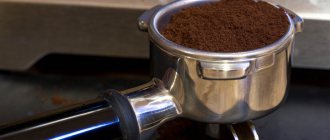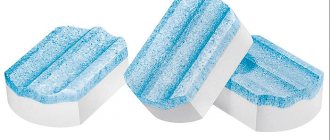Enjoy your coffee!
And remember that there is always room for experimentation - try different grains, change the grind size or water temperature. AeroPress, like Vietnamese coffee, can be prepared over ice, so you get an aromatic and refreshing drink. Try an alternative Aeropress Coffee recipe. Read about other brewing methods in our articles.
Life hack: The AeroPress is very easy to clean - remove the black cover, press the piston all the way and throw out the “pill”.
Aeropress
Related article How to make coffee in a French press.
Tips from a professional barista In 2005, the AeroPress was invented by Alan Adler, an American inventor who worked at The Boeing Company and was involved in the invention of pneumatic toys. He sought to invent a simple device for the home that could produce coffee similar to espresso. Without using an espresso machine, which are often either very expensive or cumbersome. And he came up with this thing. The AeroPress essentially works like a medical syringe. It is made of plastic, does not break, does not scratch. And it will last for a long time. If you brew coffee every day, 2-3 times, then the AeroPress will last for 5 years. What’s also pleasing is its simplicity. All you need is a paper filter (sold with the device), coffee, hot water and a cup. That's all.
Photo: AiF/Maria Tikhmeneva
Grinding For an AeroPress, a slightly finer than medium grind will work. I must say that a good coffee grinder is something that is worth spending money on.
The filter needs to be moistened with water; if you don’t do this, you will taste paper in the coffee.
Photo: AiF/Maria Tikhmeneva
Water temperature . The AeroPress requires water at 90 degrees. If you have a regular kettle, then after boiling, wait a little for the water to cool.
Question answer
How many cups of coffee can you drink a day without harming your health?
Proportions. We start from the formula: 60 g of coffee per liter of water.
Accordingly, a 250 ml cup of coffee requires 15 g of coffee. In this case, the yield of the finished drink is about 200 ml. Fortress. Coffee from an AeroPress will have more caffeine than a cup of espresso. The fact is that caffeine is released from coffee only when it comes into contact with water. For an AeroPress this is 1-2 minutes. And for espresso – 30 seconds. It just seems like you're drinking an incredibly strong, caffeinated drink. This effect is achieved due to the bright taste of coffee.
What to do. Place the AeroPress on the cup. Pour coffee into the AeroPress, add hot water and stir. It is important to stir briefly so as not to spoil the taste of the coffee. This begins the brewing process and releases caffeine into the water. We close it with a piston to prevent air movement. Pressure is created inside.
Let the coffee brew . Then you need to open, stir and close again.
And then you need to press the piston very slowly, it will resist, but will slowly go down.
We squeeze the piston all the way, raise the press and see that the coffee has already moved into the cup.
Photo: AiF/Maria Tikhmeneva
Operating principle. In fact, the principle of operation of an AeroPress is very similar to the principle of operation of a coffee machine: water under pressure passes through the coffee, brewing it, drawing out all the extractive substances from it. Only in an espresso machine the pressure is created by a pump, but here we pump it up by hand.
Photo: AiF/Maria Tikhmeneva
Difference from other types of coffee preparation
The difference between an AeroPress and other units lies primarily in the method of preparing coffee. For example, in a Chemex, pour over and French press, the process takes much longer, and the taste of the drink is not as rich.
The principle of operation of the device is in many ways similar to more complex devices, but there are still differences between them. A coffee maker or coffee machine requires constant care and thorough cleaning after each preparation. Otherwise, bacteria will begin to accumulate inside, which can harm your health and spoil the taste of the drink.
Keeping your AeroPress clean is much easier. In addition, all actions in it are performed manually.
According to true coffee lovers, only by doing the manipulations yourself will you be able to get a drink with an exquisite taste.
Hario
What is this. Hario is just a funnel, but not a simple one, but a Japanese one. The funnel can be plastic, ceramic, glass. The Japanese came up with this method of brewing; they generally have a lot of confused people about the method of brewing coffee. They even hold a championship using unconventional brewing methods.
Photo: AiF/Maria Tikhmeneva
A filter for the hario is also provided and it also needs to be moistened with water so that there are no foreign odors.
Grinding Average.
Proportions . Again, we proceed from the formula of 60 g of coffee per liter of water.
Actions . We put a funnel on a cup, put a filter in it, and pour coffee. And we begin to pour hot water over this coffee in a thin stream. You need to pour the water very slowly, you need to stretch out this pleasure for 1.5 minutes. After this, the water will pass through the coffee and drip from it drop by drop. We wait another minute and a half and you can drink coffee. The whole process takes 3 minutes.
Photo: AiF/Maria Tikhmeneva
What happened . Coffee with hario turns out very light, just like compote. This is a slightly fruity, light drink. While in the AeroPress we got a much richer taste.
Photo: AiF/Maria Tikhmeneva
Cleaning and caring for your device
The Aeropress coffee machine must be cleaned after each use. This will help it serve you as long as possible. Don't think that you can leave the coffee grounds in the flask until next time. The waste from coffee preparation releases bacteria, which settle on the walls of the vessel and will subsequently spoil the taste of your favorite drink. The cleaning process is very simple, it is no more difficult than washing a cup and will take you no more than 20 seconds. After unscrewing the lid, use a piston to push the compressed coffee grounds along with the paper filter directly into the trash container. Then wash the AeroPress under running water and leave until completely dry. The AeroPress does not require any special further care.
Quality and grinding of coffee beans
It is recommended to brew freshly ground Arabica beans in an AeroPress, especially expensive single-origin beans. The preparation method reveals the taste and aroma of coffee well. The AeroPress is suitable for coffee beans of any roast level. Acceptable grinding is both finer than average (but not fine) and coarser.
The taste of coffee brewed in an Aeropress from a mixture of Arabica and Robusta is not for everyone. The drink is somewhat stronger, but has a less refined and more bitter taste. The maximum permissible content of robusta in the mixture is 10%.
Only bottled water with a mineralization level of 75–250 mg/l is suitable for brewing coffee in an AeroPress. Baristas argue about water temperature. The general rule is that the darker the roast, the cooler the water. In any case, the temperature should not exceed +96 °C. Many competition winners recommend water temperatures between +75 and +79 °C.
A little history
Coffee came to us from the countries of the Middle East. Its homeland is considered to be Ethiopia, from where it spread to Egypt and Yemen. Europeans tried this drink in the 17th century and a hundred years later began to set up coffee plantations around the world. Coffee houses began to open in Paris and London, and the invigorating drink began to gain more and more popularity. True, at first many refused to drink it, considering it poisonous. It was even called “the devil’s drink.” However, this superstition soon disappeared, and coffee drinking became widespread. This is not surprising. It perfectly tones brain activity, is an excellent antioxidant, improves mood and increases overall vitality.
At first, coffee was brewed in a Turkish pot on sand, as was done in the East. In the 20th century, various machines for preparing the drink began to appear, simplifying this process. At home, you can also use a Turkish pot and simply cook it on the stove. Although now it has become very fashionable to purchase sets for making coffee in the oriental way - with sand and a special bowl where it is heated. For those who love technical innovations, it will be interesting to get acquainted with such an accessory as the Aeropress for coffee. Despite its recent appearance, user feedback has already been very positive.
Where to buy an AeroPress and how much does it cost?
The original AeroPress is produced by only one company, Aerobie Inc, which is located in the USA. Its products are marked accordingly, and the AeroPress name itself is a registered trademark. You will see it as a brand name on individual parts of the device - on the cylinder and stirrer, as well as on the packaging bag in which the device is supplied.
You can buy the Aerobie Aeropress in Russia via the Internet, in specialized coffee accessories stores. Price – from 3.5 to 4 thousand rubles.
To use the AeroPress you will need disposable filters. Each subsequent batch will cost from 450 to 550 rubles for 350 pieces.
If you are not satisfied with the cost of the original device, you can find copies in Chinese stores such as Aliexpress. The cost of an AeroPress is lower there - about 2,400 rubles. Delivery is often free. The quality and environmental friendliness of the AeroPress materials in this case are questionable.
Advantages and disadvantages
Among the advantages of the aeropress device, the following characteristics are worth highlighting:
- Compact sizes. The whole set can be placed in a small handbag. The device is lightweight, so its transportation is not difficult.
- Good extraction . When brewing ground coffee, you can extract maximum flavor and aroma.
- Cooking speed. The process takes about a couple of minutes in total.
- Full brewing control. A person independently chooses the grind size and determines the pressure force. This makes it possible to experiment and make coffee that exactly matches your personal preferences.
- Ease of use. It’s convenient to prepare a drink, and the AeroPress is easy to clean.
- Reliability of the design . The device is made of dense, thick plastic that is resistant to damage.
Among the shortcomings, there are only a couple of points:
- Price . Considering that the design consists of only a few plastic parts, the price is quite high.
- Additional expenses . You have to constantly buy disposable filters.
Stage two: brewing coffee
Now start brewing. The recommended dose of ground powder per person is 17 grams. Pour the required amount into the bottom of the press and fill it with boiled water to mark three. Please note that pouring boiling water over coffee is not recommended; it is better to let the water cool for a minute. Particularly meticulous cooks advise using water at 80-85 degrees. Using a special kitchen thermometer you can easily measure it. After thoroughly stirring the drink with a spoon, add more water up to the two mark. Now you can close the Aeropress with a lid with a filter. After a few minutes, you can pour your drink into the cup.
Coffee from the championships in my AeroPress
I was able to try the official coffee of the AeroPress championships in some countries. I’ll tell you more about the most interesting varieties.
Coffee of the Russian championship - Colombia Hacienda San Alberto La Alzazia (roasted by Sweet Beans). I tried it as a participant in this championship. During preparation and within the framework of the championship itself, we were able to taste several dozen variants of the drink prepared from this variety using an AeroPress. This coffee is washed and light roasted. It is very clean, bright, fruity and consistent. It was almost impossible to spoil it. No matter what you did with it, the result was a delicious cup. But this, no matter how paradoxical it may be, also contains a minus, albeit a minor one - a narrow range of taste.
The next coffee I want to talk about is Indonesia Lintong Pilihan - the choice for the Aeropress championship in Belarus. Varieties - typica and catimor, altitude 1400-1550 m, processing - semi-washed, medium roast (corresponds to group “C” of Torrefacto). This is brutal coffee, with character! Each time is different. This is exactly the kind of coffee you need to work with: you can get a masterpiece cup, or you can get a disastrous one.
Having received vivid impressions from Lintong Pilihan coffee, I tried to prepare many more coffees from Indonesia in the AeroPress from different generalists. In my opinion, coffee from this region (primarily from the island of Sumatra), medium roast and AeroPress is an ideal combination. I recommend everyone to try it.
What was very intriguing for me was the choice of coffee in the homeland of espresso – Italy. I was expecting coffee roasted darker than average and was surprised when I saw light beans in the pack. For their Aeropress championship, the Italians chose naturally processed coffee from Ethiopia - Ethiopia Kana Yirgacheffe. This is light, I would even say, gentle coffee. The taste and aroma are of fruits and flowers. But the main thing that amazes you about this coffee is the aftertaste: long, clean and very floral. Memorable coffee. Even though this coffee was “meant” for the AeroPress, I liked it better in the funnel. This Ethiopia requires a “delicate” approach; you don’t want to “put pressure” on it.
Perhaps the most unusual coffee was chosen for the South Korean AeroPress Championship. Washed coffee from Colombia Inmaculada Rume Sudan. Its uniqueness is a rare variety - rumeh sudan. Rume Sudan gained worldwide fame largely due to the fact that Sasa Sestic won the World Barista Championship 2020 with it. Rume Sudan is a very bright and powerful coffee. It seems to me that he can easily compete with a geisha. In 2020, Tim Wendelboe conducted a comparative cupping of more than 50 varieties of coffee at the Los Pirineos farm in El Salvador. Rume Sudan has won! Rume Sudan comes in the Torrefacto variety from a coffee garden in Costa Rica.
Based on my experience of preparing Inmaculada Rumé Sudan in an AeroPress, I can say that this is a very unusual coffee. Very bright. The taste was distinctly honey and fig (I had never encountered this descriptor before). The body is dense. Opens up perfectly in the AeroPress.
To sum it up subjectively, I can say that the Aeropress produces the most interesting and tastiest varieties with a dense body and bright fruity acidity. Washed processing for cooking in an AeroPress seems preferable to me: under pressure, the enzyme characteristic of natural processing often begins to dominate the taste and “contaminate” it. My favorites (not counting unique varieties) among countries of origin are Kenya and Indonesia.











